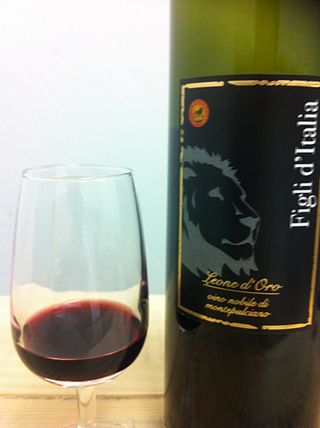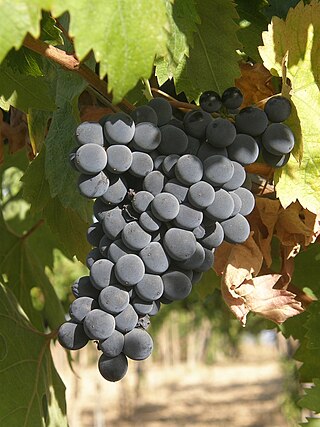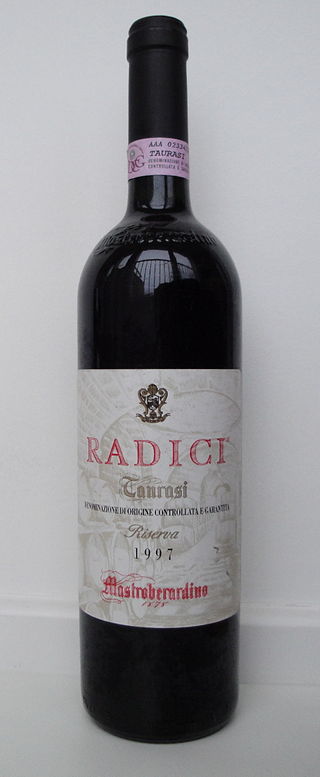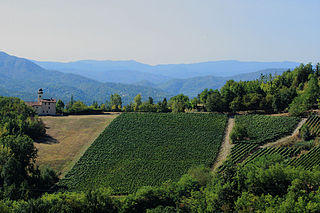
Amarone della Valpolicella, usually known as Amarone, is an Italian DOCG denomination of typically rich dry red wine made from the partially dried grapes of the Corvina, Rondinella (5–30%) and other approved red grape varieties.

Barolo is a red denominazione di origine controllata e garantita (DOCG) wine produced in the northern Italian region of Piedmont. It is made from the nebbiolo grape and is often described as one of Italy's greatest wines.

The following four classifications of wine constitute the Italian system of labelling and legally protecting Italian wine:

Vernaccia di San Gimignano is a white Italian wine, made from the Vernaccia grape, produced in and around the Italian hill town of San Gimignano, in Tuscany. It was the first Italian wine to be awarded denominazione di origine controllata (DOC) status in 1966; on July 9, 1993, it was upgraded to denominazione di origine controllata e garantita (DOCG).

Brunello di Montalcino is a red DOCG Italian wine produced in the vineyards surrounding the town of Montalcino, in the province of Siena, located about 80 km south of Florence, in the Tuscan wine region. Brunello, a diminutive of bruno, is the name that was given locally to what was believed to be an individual grape variety grown in Montalcino. In 1879 the province of Siena's Amphelographic Commission determined, after a few years of controlled experiments, that Sangiovese and Brunello were the same grape variety, and that the former should be its designated name. In Montalcino the name Brunello evolved into the designation of the wine produced with 100% Sangiovese.

Aglianico del Vulture and Aglianico del Vulture Superiore are Italian red wines based on the Aglianico grape and produced in the Vulture area of Basilicata. Located on volcanic soils derived from nearby Mount Vulture, it was awarded Denominazione di Origine Controllata (DOC) status in 1971. The Superiore was elevated to a separate Denominazione di Origine Controllata e Garantita (DOCG) status in 2011, the only DOCG wine in Basilicata.

Vino Nobile di Montepulciano is a red wine with a denominazione di origine controllata e garantita status produced in the vineyards surrounding the town of Montepulciano, Italy. The wine is made primarily from the Sangiovese grape varietal, blended with Canaiolo Nero (10%–20%) and small amounts of other local varieties such as Mammolo. The wine is aged for 2 years ; three years if it is a riserva. The wine should not be confused with Montepulciano d'Abruzzo, a red wine made from the Montepulciano grape in the Abruzzo region of east-central Italy.

Montepulciano d'Abruzzo is an Italian red wine made from the Montepulciano wine grape in the Abruzzo region of east-central Italy. It should not be confused with Vino Nobile di Montepulciano, a Tuscan wine made from Sangiovese and other grapes.

Fara Novarese is a comune (municipality) in the Province of Novara in the Italian region of Piedmont, located about 80 kilometres (50 mi) northeast of Turin and about 15 kilometres (9 mi) northwest of Novara.

Brachetto is a red Italian wine grape variety grown predominantly in the Piedmont region of northwest Italy. At one time the grape was thought to be related to the French wine grape Braquet, but recent thought among ampelographers is that the two are distinct varieties. In Italy's region of Piedmont the grape is somewhat more widespread: production mostly falling within an area of the provinces of Asti and Alessandria between the rivers Bormida and Belbo plus various parts of the province of Cuneo. At Canelli, on the border between the hills of Asti and the Langhe proper, the grape is known as Borgogna. The most notable wine here is the red Brachetto d'Acqui Denominazione di Origine Controllata e Garantita (DOCG) which is made in both still and spumante versions. The Piemonte Brachetto Denominazione di Origine Controllata (DOC), also a red wine, is made with a minimum of 85% Brachetto; it is usually still, but may be frizzante. The grape is also used for up to 10% of the blend for the Ruché-based Ruché di Castagnole Monferrato DOCG.

Bardolino and Bardolino Superiore are Italian red wines produced along the chain of morainic hills in the province of Verona to the east of Lake Garda. Bardolino takes its name from the town Bardolino on the shores of Lake Garda and was awarded Denominazione di origine controllata (DOC) status in 1968. The Superiore is a stronger aged wine, and was promoted to Denominazione di origine controllata e garantita (DOCG) status in 2001. The blend of grapes used to produce the wine primarily includes Corvina, Rondinella, and Molinara. Up to 15% of the blend is allowed to include Rossignola, Barbera, Sangiovese, or Garganega, in any combination.
Gattinara is a red Italian wine with denominazione di prigine controllata e garantita (DOCG) status produced from Nebbiolo grapes grown within the boundaries of the comune of Gattinara, which is located in the hills in the north of the province of Vercelli, northwest of Novara, in the Piedmont region. It was awarded DOC status in 1967 and received its DOCG classification in 1990.

Taurasi and Taurasi riserva are red, still Italian wines based principally on the Aglianico grape variety produced in the province of Avellino in the Campania region. They were awarded denominazione di origine controllata (DOC) status in 1970 and denominazione di origine controllata e garantita (DOCG) status in 1993. Produced less than 40 miles (64 km) from the other Aglianico stronghold of Aglianico del Vulture in Basilicata, the volcanic soils of the Taurasi region demonstrate the potential the Aglianico grape has to make wines on par with the Nebbiolo grape of Piedmont and Sangiovese grape of Tuscany. The popularity of the region's wine is a relatively recent phenomenon. Until the early 1990s, there was only one winery (Mastroberardino), producing wine for the export market. By the mid-2000s, there were over 293 producers in the Taurausi zone.

Piedmont wine is the range of Italian wines made in the region of Piedmont, in the northwestern corner of Italy. The best-known wines from the region include Barolo and Barbaresco. They are made from the Nebbiolo grape. These wines are ideal for storage and a well-aged Barolo for instance may leave a feeling of drinking velvet because the tannins are polished and integrated more and more into the wine. As the wine matures the colour becomes more brownish and rust-red.
Uva Rara is a red Italian wine grape variety that is grown in the Piedmont and Lombardy wine regions of northern Italy. The grape is a permitted blending variety along with Nebbiolo in the Denominazione di Origine Controllata e Garantita (DOCG) wines of Ghemme. In the Denominazione di Origine Controllata (DOC) wine region of Oltrepò Pavese the grape is often blended with Barbera and Croatina. While Uva Rara's name means "rare grape" in Italian, the variety is actually widely planted with 608 hectares of the vine recorded in Italy in 2000.
Abrusco is a red Italian wine grape variety grown primarily in the Tuscany region where it is a minor blending component permitted in the wines of Chianti. The grape has long history in the region and was mentioned in 1600, under its synonyms Abrostino and Colore, in the posthumously published work by Italian agronomist Giovan Vettorio Soderini Trattato della coltivazione delle viti, e del frutto che se ne può cavare. There Soderini notes that the grape was often used to add deeper, more red color to Tuscan wines.
Romagna Albana is a white, still Italian wine based principally on the Albana grape variety produced in Bologna, Forlì-Cesena and Ravenna. It was awarded Denominazione di Origine Controllata (DOC) status in 1967, and promoted to Denominazione di Origine Controllata e Garantita (DOCG) in 1987, with a name change instituted in 2011.

Brachetto d'Acqui is a red Italian wine that is classified as a Denominazione di Origine Controllata e Garantita (DOCG) since 1996 and previously a Denominazione di Origine Controllata (DOC) region since 1969. It is produced in the Piedmont wine region around Acqui Terme in the province of Alessandria with some overlap into the province of Asti. The wine is produced from the Brachetto grape, a variety that is believed to be native to Piedmont, and can be still or sparkling with usually some sweetness.
Rossola nera is a red Italian wine grape variety that has been growing in the Valtellina region of Lombardy since at least the 17th century. In 2004 DNA profiling determined that the grape has a parent-offspring relationship with the Piedmont wine grape Nebbiolo though which variety is the parent and which is the offspring is not yet clear. However, most ampelographers believe that Nebbiolo is likely the parent variety since written records in Piedmont have noted Nebbiolo being grown since at least the 13th century.














